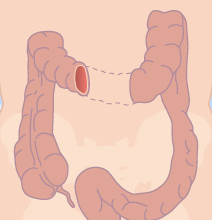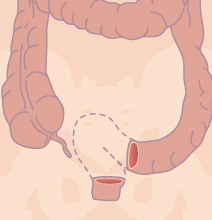Colostomy
If the surgeon, after removing the cancer, cannot connect the colon (or rectum) healthy tissue to the sphincter, a colostomy may be necessary.
This consists of creating an artificial orifice on the lower part of the abdomen, connecting the colon to the exterior. In this way, the food residues instead of passing through the rectum are collected in a bag adapted for the purpose (without odors). If the connection to the outside is for the small intestine and not the colon, the surgery is called ileostomy.
A colostomy can be temporary, a way to allow the healthy tissues of the colon, rectum or anus to recover from the damage caused by the cancer treatments (surgery, chemotherapy or radiotherapy). Once these tissues have recuperated, an operation reverses the colostomy, bringing the digestive system together inside the body.
When the connection to the anus is not possible, the colostomy can be permanent.





